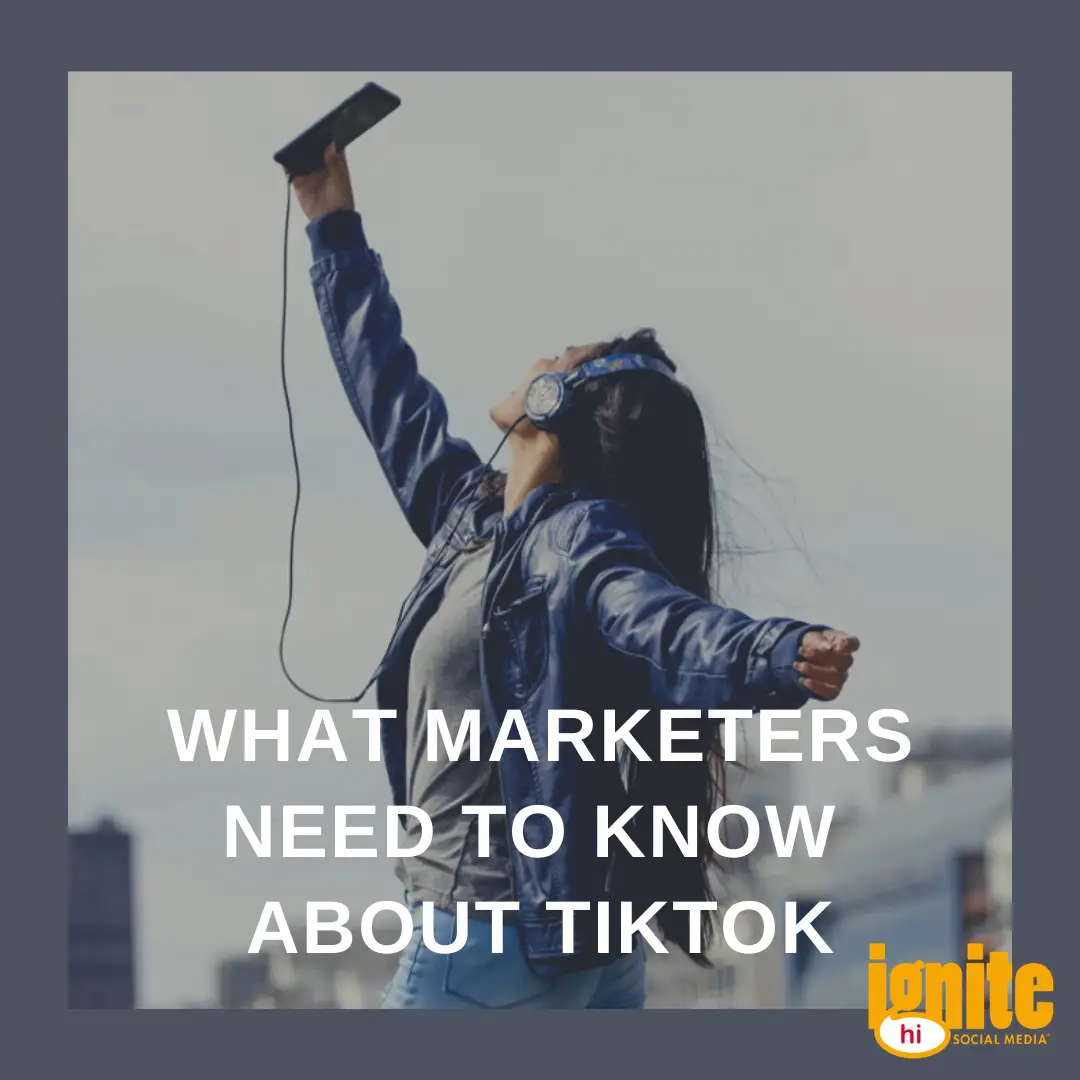
02 Apr What Marketers Need to Know About TikTok
This post was updated September 2020
Key Takeaways
- TikTok is a bite-sized social video platform that allows users to create, share, and edit videos with built-in tools that make it easy for anyone to add music or special effects
- 42% of users fall into the Generation Z demographic and more women are found on the app versus men.
- Monthly Active Users have grown 66% since the pandemic (Q1 data compared to Q2)
- Brands seeing success on the platform are authentic in the content they are creating
- The platform has 5 ad units which have large minimum spends; their self-serve ads platform was opened up to the public in July 2020
What is TikTok?
TikTok is a bite-sized social video platform that allows users to create, share, and edit videos with built-in tools the make it easy for anyone to add music, implement special effects, and join in on the latest trends. Its origins here in the West can be traced back to 2014’s Musical.ly app, which was acquired by the Beijing-based media company, ByteDance, who had launched the original TikTok app in China in 2016.
Since its acquisition TikTok has exploded in popularity, boasting over 2 billion global app downloads and over 500 million monthly users, placing it ahead of other social networks such as Twitter, Snapchat, and Pinterest.
TikTok was the 7th most downloaded app of the 2010’s and climbed to the #2 spot in March of 2020.
We recently hosted a webinar on TikTok. You can view the recording below:
Who is Using TikTok?
In short: Gen Z. Just under 50% of TikTok’s user base falls into the Gen Z demographic, so it’s definitely not your imagination if it all feels like a young kid’s game. However, as TikTok continues to surge in popularity a growing number of adults in the United States have begun adopting the platform. Millennials come in second with 34% now using the app.
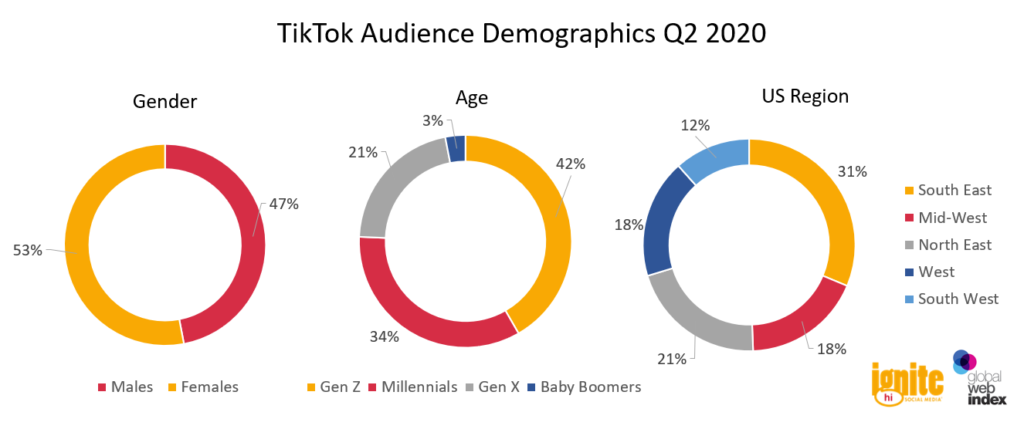
Recent data shows there are now 100M US monthly active users on TikTok, (a 66% growth since the pandemic) and therefore about 42M of those users are Gen Zers. We did some research and found that there are approximately 67M Gen Zers in the US, which means 60% of Generation Z in the US can be found on the platform. While we fully expect TikTok to remain a platform geared towards that younger audience, there’s an increasing opportunity to reach adults on the platform as well.

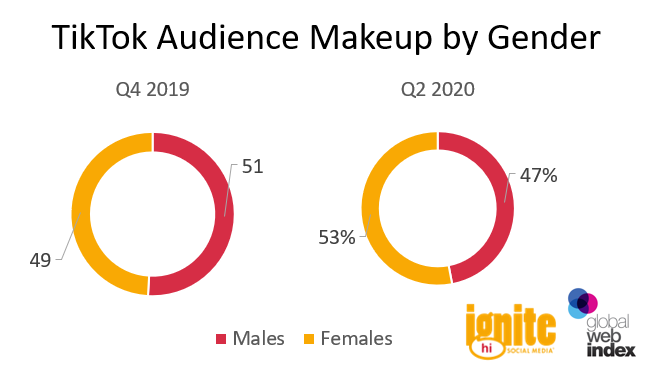
It’s also interesting to see which gender is primarily using TikTok. Back in Q4 of 2019 GlobalWebIndex data showed that males slightly dominated the app, but as the platform grew in popularity, more women can be found on TikTok.
We also looked at time spent on TikTok. TikTok users are opening the app 8x per day and spending about 52 minutes/day on TikTok. This time spend is equivalent to the time spent on Facebook and Instagram and higher than the time spent on Twitter and Snapchat.
Who is not currently on TikTok, however, are brands! As of May 2019, eMarketer found that only 4% of US social media marketers are currently involved with the platform. Part of this is due to the tricky nature of crafting content on a platform geared towards more personal and less produced content, but the company has introduced new tools to make it easier for brands to both connect with potential influencers and create challenges to get involved with fans. There’s a huge opportunity for brands to break through on the platform this year.
Brand Watch-Outs
Terms of Service
An important watch-out for brands comes from TikTok’s Terms of Service (you can dive into their Terms of Service here). One thing that has stood out to us is that TikTok has unlimited rights to re-use and repurpose your content (royalty-free, fully transferable, on any platform they want). The person or brand retains the copyright, but TikTok can repurpose the content in any way they want to.
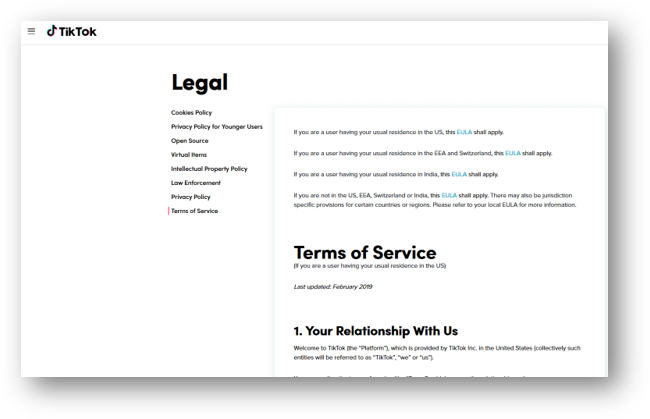
Privacy Concerns and New Ownership
In the middle of the pandemic, TikTok was frequently in the news regarding potential cybersecurity threats, and because of this, TSA agents and people in the military have been prohibited from using the platform.
President Donald Trump also raised concerns and threatened to have the app blocked from U.S. app stores if TikTok’s Chinese owner, ByteDance, did not sell the U.S. division of the company to a U.S. business. However, on September 19, 2020, gave his “blessing” to the marriage of TikTok and major U.S. corporations Oracle and Walmart. Oracle and Walmart will reportedly take a combined 20% stake in the new company, TikTok Global. ByteDance is expected to keep 80%. But seeing as American interests control 40% of ByteDance, the new company will have majority U.S. ownership, per the Trump administration.
What Type of Content Works & Doesn’t Work on TikTok?
What Works
Keep it casual–No matter the type of content you seek to create on TikTok you’ll want to avoid giving it too polished of a look. Keep the high-grade cameras in your bag and the effects as native to the app as possible.
Be real— It’s the antithesis of Instagram’s heavily curated, glossy versions of ourselves. Authenticity matters here, so let your hair down!
Stories over news–Users on TikTok are there to be entertained, not spoken or marketed to. Instead of focusing on product information and updates, think about how you can continue telling the story of your brand, the people who make it possible, and how your products play a key role in that lifestyle.
What Doesn’t Work
Traditional video content–If it was intended for TV, your YouTube or Facebook pages, it probably won’t work on TikTok.
Bandwagoning–You’ll want to be aware of which trends work well with your brand and which to avoid. Among TikTok’s teen audience, brands encroaching on the platform is already a hot button issue and jumping on unnecessary trends can be seen as a lame move.
Improperly formatted video— Be sure your content adheres to the 9:16 vertical format on TikTok! Whether you film your content in the app itself or produce it elsewhere, it absolutely must be in a vertical format, and under either the 15-second or 60-second limit.
Unique Features of TikTok
Sounds: The primary feature of TikTok that you need to know and understand are sounds and how to use them. Tapping the sounds button will open a new window that allows you to browse from seemingly infinite soundtracks for your videos from pop favorites, currently trending clips, as well as your bookmarked sounds.
One of the most important habits to learn while adapting to TikTok is bookmarking sounds along with following individual creators. If you notice a trending sound that you like, bookmark it and then you can scroll through all the videos using that sound later.
Effects: If you’ve seen a crazy special effect in a TikTok video, this is where you’ll find them! Not only can you save the ones you love to your favorites, but you can also do it straight from any TikTok video that uses a built-in effect.
Duets: TikTok allows creators to not only “Like” and comment on each other’s videos but respond directly to them in their own feed with a TikTok of their own! For this functionality to work, you must enable Duets during the final step of the publishing phase via the “Allow Duet and React” button.
Example Best-in-Class Brands on the Platform
Chipotle (tiktok.com/@chipotle): Chipotle is a fantastic example of a brand embracing the unique qualities of the TikTok platform. Their videos speak to the relatable aspects of the Chipotle customer experience with content that doesn’t look out of place or beyond that of your average person’s feed. Their straight-forward approach to the platform also allows them to seamlessly integrate influencers into their content stream. They have also launched several Challenges on the platform, such as the #ChipotleLidFlip challenge and #GuacDance around National Avocado Day.
Washington Post (tiktok.com/@washingtonpost): A newspaper dating back to 1877 isn’t a brand you’d expect to find on TikTok, but they’ve made it work by being authentic and on top of trends. A mixture of behind-the-scenes moments and odd memes have made them the “boomer darlings” of the youth-focused app. They do a great job executing skits, stunts and workplace humor to bring in a younger audience.
Fenty Beauty (tiktok.com/@fentybeauty): The two keys to Fenty’s success on TikTok are authenticity and inclusivity. The cosmetic brand’s approach to TikTok features plenty of behind-the-scene videos showcasing real people utilizing their products without overly producing or touching up the videos, all while featuring a diverse cast, including men who are fans of their beauty products.
In March, Rihanna opened a Fenty Beauty House in LA to bring together TikTok content creators and beauty bloggers in one place to access products and have the tools to create content. That effort has since been paused with COVID-19, but it is a really cool activation of a brand bringing creators together to make content for the platform.
Paid Media Opportunities
Ad Units
TikTok currently offers five ad units in the U.S. including In-Feed Native Video, Branded Takeovers, TopView, Branded Hashtag Challenges, and Branded Effects.
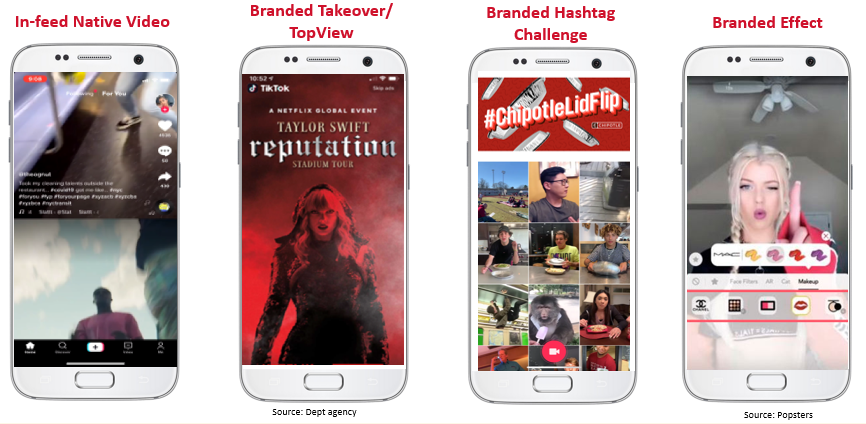
In-Feed Native Video: Full-screen video that appears in-feed, alongside user videos. The ad unit can drive users to an external or internal landing page or app. There are also seven CTA options available: “Show Now”, “Download Now”, “Learn More”, “Sign Up”, “Contact Us”, “Apply Now” and “Book Now”.
Branded Takeover: Full-screen takeovers that appear when a user opens the app. The 3-second-long still image or 3- to 5-second video takeover can drive users to an external or internal landing page.
TopView: Combines the Branded Takeover concept with a first-in-feed position. After the first 3 seconds, the video turns into the in-feed post.
Branded Hashtag Challenge: Encourages users to create and share content on TikTok using a branded hashtag.
Branded Effect: Animated lenses triggered by facial and hand movements, along the lines of Snapchat lenses.
Costs
As with any platform new to the ad space, advertising on TikTok is limited to brands with larger marketing budgets. Ads are bought through a managed service, so brands must meet minimum spends and work with a representative to place ads.
However, in July 2020 TikTok opened up their self-serve platform that greatly benefits SMB business with smaller budgets. However, brands still must spend a minimum of $50 per day ad the campaign level ($20 per day at the ad group level).
Targeting Capabilities

TikTok’s targeting capabilities are currently limited to demographic (age, gender, geography, language), interest category, custom and lookalike audiences, and device. This may be one reason why, in a March 2019 survey by Digiday, U.S. media executives rated TikTok as having the lowest targeting capabilities when compared to select digital platforms including Google search, Facebook, and Instagram.
TikTok is a young platform for a young audience. As the app gains momentum in the U.S. market and acquires more capital to ramp up their offerings, we expect to see growth in their targeting capabilities.
Activating Influencers on TikTok
Because TikTok is designed for rapid video consumption, it’s an excellent channel for brands and influencers to partner together. That said, TikTok isn’t like Facebook and Instagram, and the way in which you can partner with influencers varies. From identifying partners to FTC disclosures to measuring analytics, it can get a little messy. Check out this post that dives into everything you should know about partnering with TikTok creators to fully understand what these partnerships could look like.
Want to learn more about TikTok marketing and the latest social media trends? Subscribe to our Social You Should Know newsletter below and we’ll deliver the latest information right to your inbox.








